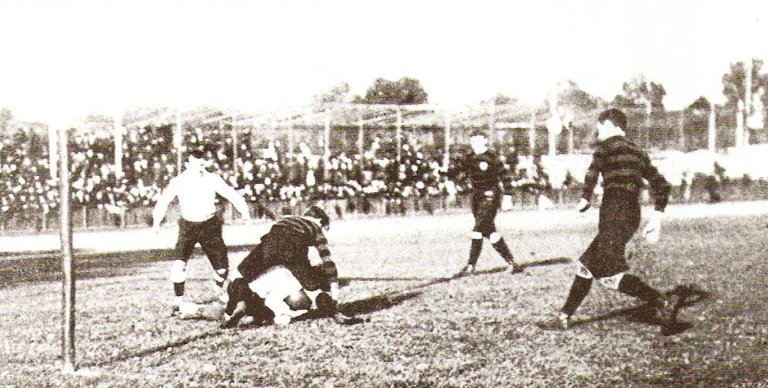
Feetball is one of the most popular sportsball leagues in the world, a league in which two teams, or 'scrums,' strive to place a ball into the opposing scrum's gaol using, depending on the phase of play, either primarily or exclusively their feet.
Feetball is a league of surpassing intricacy and elegance, with a thousand and one nuances and variations. It would be all too easy to wax eloquent about the role of the offside punting regimen or endlessly debate the optimal number of players to place on the pitch at one time.
However, for the purpose of this overview we will limit ourselves to a discussion of the balls, with a brief discursus on the Rugby Escalation.
The Balls
Feetball is played with two balls: the round-ball, often known colloquially as the 'dumpling,' and the long-ball, or 'spheroidalon.' The game is typically started with the round-ball for the fielding phase, during which the gaming field is known as a 'pitch.' The game may then escalate to the use of the spheroidalon for a special pitching phase, during which the pitch is known as a 'field.'
The Round-Ball
In most cases it is not legal to touch the round-ball with one's hands. The gaoler is the only player who may touch the dumpling with his hands, except within the penalty box. The penalty box comprises an area of 12 farthings immediately surrounding the gaol, within which any player in good standing may make an overhead pass toward the goal. This move is often known colloquially as 'chucking the biscuit.'
Chucking the biscuit (or, more properly, the dumpling) away from the gaol may result in an offside penalty, in which the offending team lines up in the penalty box and the opposing team is allowed one chance to kick the round-ball in an attempt to knock down as many players as possible, removing them from play.[1]
The emphasis on kicking in round-ball play has led to the development of specialized kicking-stockings for the players. As a result the fielding phase is occasionally called 'socker,' known as the Beautiful Name.
The Spheroidalon
The long-ball is introduced when conditions require a pitching phase. Typically this occurs when the total number of forwards on the pitch exceeds seven, when punts are broken, or when the chief barrister throws a red flag, indicating high winds or excessive violence. The pitching phase begins with a drive, in which the spheroidalon is balanced on a small white stand called a tee for the prop forward to kick at the opposing team's catcher, also known as a short stop.[2]
Handling rules for the spheroidalon are more permissive, especially in the Western and Southern Hemispheres. This permissiveness brings its own complications, along with a wealth of strategic options. The primary long-ball moves include throwing, kicking, punching, mauling, delving, and remuneration. Just as the dumpling must generally be moved without use of hands, the long-ball may only be legally moved away from the target goal, with rare exceptions.
During the pitching phase, the gaols are raised to allow for aerial scoring, with the penalty box extended to form a trying zone, demarcated by the end line. Aerial scoring can take the form of a punt, a kick-off, or a header. The long-ball can also be carried bodily into trying zone for a touchback, an interception, or a 3-point conversion, worth 3 points.[3]
The Rugby Escalation
The pitching phase is usually broken up into a series of downs, called overs in European play. However, at the discretion of the quarterback or the gaoler the Rugby Escalation may be invoked, at which time play becomes continuous. During a rugby escalation, any player may tackle any other player, and players may switch teams at will.
Rugby feetball typically consists of a large group of players, known as a tackle, struggling for control of the long-ball. The pointed ends of the spheroidalon often become flattened over the course of this struggle, which, however, generally changes the long-ball's aerodynamics in a way that makes it easier to score a touchback.
Some regions favor the fielding phase and others the pitching phase, and in many cases the pitching phase--or even a rugby escalation--is entered almost immediately, and the dumpling dispensed with.
Dear Reader - Thank you for joining us in this early foray into the complex and entrancing world of feetball. If you have spotted any omissions or errors in this brief introduction, please use the comments area below to send us your comments, corrections, and expansions.
We also welcome any questions you may have about feetball and invite the greater sportsball community to assist us in addressing the questions of any newcomers.
With your support, we hope in future features to delve into the nuances of feetball scoring, player positions, etc., as well as the companion leagues such as handsball and batsball.
---
1. Since the introduction of the hollow round-ball in the 1890s and increasingly modern strength-training regimens, offside penalties nowadays frequently result in a no bowl, with no players knocked out of play.
2. If the prop forward manages to kick the ball into the pocket, the scrum scores an automatic ruckus, worth 4 points (6 in union league).
3. In union league play a 3-point conversion is worth 2 points.
I think you will probably go over the head of most people with this... This sounds like something you would include in a Harry Potter type fantasy novel.
Hahaha - you mean spheroidalon isn't part of the common vocabulary?
Congratulations @byfaroe! You have received a personal award!
Click on the badge to view your Board of Honor.
Congratulations @byfaroe! You received a personal award!
You can view your badges on your Steem Board and compare to others on the Steem Ranking
Vote for @Steemitboard as a witness to get one more award and increased upvotes!
Good thoughts